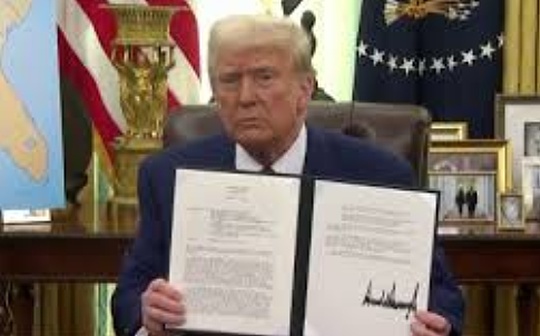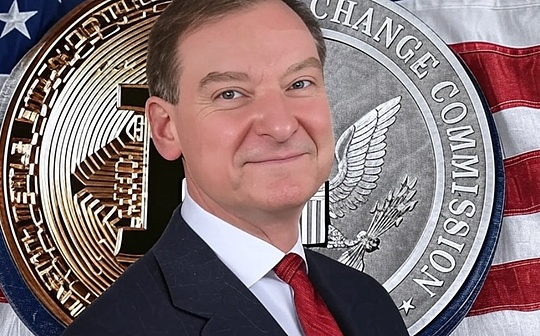
source:The White House of the United States;Compiled: bitchain vision
Memorandum of Reciprocal Trade and Reciprocal Tariffs
To: Secretary of Treasury, Secretary of Commerce, Secretary of Homeland Security, Director of the Office of Management and Budget, U.S. Trade Representative, Presidential Assistant for Economic Policy, Presidential Senior Advisor to Trade and Manufacturing
Section 1 Background
The United States is one of the most open economies in the world, with an average weighted tariff rate also ranks among the lowest.The United States has fewer barriers to imports than other major world economies, including those with similar political and economic systems.For years, the United States has been treated unfairly by trading partners, both friends and enemies.This lack of reciprocity is one of the root causes of the huge and continuous annual trade deficit in my country’s goods – the closure of foreign markets has led to a decrease in US exports, while the opening of domestic markets has led to an increase in imports.
Our workers and industries are the first to be hit by unfair practices and cannot access foreign markets.As stated in the Presidential Memorandum of January 20, 2025 (America First Trade Policy Memorandum) , this situation cannot be maintained.The U.S. trade deficit threatens our economic and national security, hollows out our industrial base, reduces our overall national competitiveness, and makes our country rely on other countries to meet our critical security needs.By making trade more reciprocity and balance, we can reduce the trade deficit; develop the U.S. economy; improve trade relations with trading partners, and benefit American workers, manufacturers, farmers, ranchers, entrepreneurs and businesses.
Section 2 Policy
The U.S. policy is to reduce our ongoing trade deficit in commodity trade that we continue every year and to address other unfair and imbalanced aspects of trade with foreign trading partners.To implement this policy, I will launch the “Fair and Reciprocity Plan” (Plan).Under the plan, the current government will vigorously respond to non-reciprocal trade arrangements with trading partners and determine the same as the reciprocal tariffs with each foreign trading partner.This method will beComprehensive, reviewUSANon-reciprocal trading relations with all trading partners, including:
(a) tariffs imposed on U.S. products;
(b) unfair, discriminatory or extraterritorial taxes imposed by our trading partners on U.S. businesses, workers and consumers;
(c) Costs incurred on U.S. businesses, workers and consumers due to non-tariff barriers or measures, as well as unfair or harmful conduct, policies or practices (including subsidies) and heavy regulatory requirements for U.S. businesses operating in other countries;
(d) policies and practices that cause exchange rates to deviate from market value and harm the interests of the American people; lower wages; and other mercantilist policies that reduce the competitiveness of American businesses and workers; and
(e) Any other that the U.S. Trade Representative considers that any unfair restrictions on market access or any structural barriers to fair competition with the U.S. market economy, as considered by the U.S. Trade Representative, in consultation with the Treasury, the Secretary of Commerce and Senior Advisor of the Presidentpractice.
The plan should take into account the losses caused by the implementation of measures that are not conducive to the United States, regardless of the name of these measures, whether written or non-written, to ensure a comprehensive fairness and balance of the entire international trade system.
Section 3 Take Action
(a) After submitting a designated agency report under the America First Trade Policy Memorandum,The Secretary of Commerce and the U.S. Trade Representative shall consult with the Secretary of Treasury, Secretary of Homeland Security, Presidential Assistant to Economic Policy, Presidential Senior Advisor to Trade and Manufacturing, and other heads of executive departments and agencies deemed relevant by the Secretary of Commerce and the U.S. Trade Representative in accordance with their respective laws, take all necessary actions to investigate the damage caused to the United States by any non-reciprocal trade arrangement adopted by any trading partner.After completing such necessary actions, they should submit to me a report detailing the remedies proposed for establishing a mutually beneficial trade relationship with each trading partner.
(b) Within 180 days from the date of publication of this memorandum, the Director of the Office of Management and Budget shall assess all financial impacts on the federal government and the impact of any request for information collection on the public and submit a written assessment report to the President.
Section 4 Definition
For this memorandum:
(A) “VAT” refers to a consumption tax that is levied on the incremental value of goods or services at each stage of the supply chain.
(b) “Non-tariff barrier” or “Measures” means any measures or policies or non-monetary barriers taken by the Government to limit, prevent or hinder international trade in goods, including import policies, sanitary and phytosanitary measures, technical trade barriers, governmentProcurement, export subsidies, lack of intellectual property protection, digital trade barriers, and anti-competitive behavior of state-owned or private enterprises that the government tolerate.
Section 5 General Provisions
(a) Nothing in this memorandum shall be construed as weakening or otherwise affecting:
(i) the powers granted by law to an administrative department or agency or its chiefs; or
(ii) Functions of the Director of the Office of Management and Budget relating to budget, administrative or legislative proposals.
(b) The implementation of this memorandum shall comply with applicable laws and shall be subject to the grant.
(c) This memorandum does not intend and does not create any right or interest, whether substantive or procedural, and any party may, in accordance with the law or fairness, against the United States, its departments, institutions or entities, its officials, in accordance with the law or fairness., an employee, an agent or any other person enforces such rights or interests.
(d) The U.S. Trade Representative has the right and is directed to publish this memorandum in the Federal Register.
Fact sheet:
“Fair Reciprocity Plan”:
On February 13, 2025, President Trump signed a presidential memorandum ordering a comprehensive plan to restore fairness in U.S. trade relations and combat non-reciprocal trade arrangements.
-
The Fair and Reciprocity Program will seek to correct the long-standing international trade imbalance and ensure overall equity.
-
Gone are the days when the United States was used: This program will put American workers first, improve our competitiveness in every industry, reduce our trade deficit, and strengthen our economy and countrySafety.
The United States will no longer tolerate unfair trade practices:
The United States is one of the most open economies in the world, but our trading partners close markets for our export products.This non-reciprocity is unfair and leads to a huge and persistent trade deficit every year.
-
There are endless examples of our trading partners not giving reciprocity to the United States.
-
The U.S. tariffs on ethanol are only 2.5%.Brazil imposes a 18% tariff on U.S. ethanol exports.As a result, in 2024, the United States imported more than $200 million in ethanol from Brazil, while the United States exported only $52 million in ethanol to Brazil.
-
The average most-favored-nation tariff on agricultural products is 5%, while India’s average most-favored-nation tariff is 39%, India also imposes 100% tariff on U.S. motorcycles, while we only impose a 2.4% tariff on Indian motorcycles.
-
The EU can export all the shellfish you want to the United States.But the EU bans the export of shellfish in 48 states of the United States, despite the U.S. pledges to speed up shellfish export approvals in 2020.As a result, in 2023, the United States imported $274 million worth of shellfish from the EU, but exported only $38 million.
-
The EU also imposes a 10% tariff on imported cars, while the U.S. imposes a 2.5% tariff.
-
A 2019 report found that U.S. exporters face higher tariffs over two-thirds of the time in 132 countries and over 600,000 product lines.
-
This lack of reciprocity is one of the reasons for the continued huge trade deficit in the United States every year: closed overseas markets reduce U.S. exports, while open domestic markets lead to large U.S. imports, both of which weaken U.S. competitiveness.
-
Since 1975, the United States has experienced a commodity trade deficit every year.In 2024, our commodity trade deficit exceeded US$1 trillion.
-
The U.S. is currently experiencing a trade deficit in agriculture, which will reach about $40 billion by 2024 due to the surge in non-reciprocal barriers over the past few years.
-
Although the United States does not have such taxes, and only the United States should be allowed to tax U.S. companies, trading partners have filed bills for U.S. companies for what they call digital service tax.
-
Canada and France use these taxes to collect more than $500 million in revenue from U.S. companies each year.
-
Overall, these non-reciprocal taxes cause more than $2 billion in losses to U.S. businesses each year.
-
Reciprocal tariffs will restore the distorted international trading system to fairness and prosperity and prevent Americans from being exploited.
The Art of International Trading:
President Trump continues to fulfill the mission entrusted to him by the American people and implements American priority in trade.
-
As President Trump said on his first day in office in the America First Trade Policy Memorandum, trade policy is a key component of our economic security and national security.
-
During President Trump’s first term, he successfully ended the outdated and unfair NAFTA and replaced it with the historic U.S.-Mexico-Canada agreement, bringing the greatest victory for American workers.one.
-
When our national security is threatened by a global oversupply of steel and aluminum, President Trump acted quickly to impose tariffs on the import of these goods to protect the national security of the United States.
-
In response to unreasonable acts such as China’s theft of intellectual property rights and forced technology transfer, President Trump decisively took additional tariff measures and took advantage of this to reach a historic bilateral economic agreement.
Just last week, President Trump used tariffs to force Canada and Mexico to make long-awaited changes on our northern and southern borders to ensure the safety of U.S. citizens.








